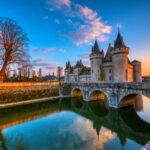Rome Travel Guide
Introduction
Rome (Map) is one of the most-visited cities in the world, with 20 million visitors per year. The city is a popular tourist destination, a vibrant mélange of historical ruins and modern architecture. With Eat, Pray, Love has added to the general quaint charm of Rome, walking the cobbled streets and soaking in la dolce vita (the sweet life) is one of the best experiences to have in the city. As you peel through its fascinating and jumbled layers, you’ll find the marble ruins of ancient times, tangled streets of the medieval world, early Christian churches, grand Renaissance buildings and statues, Baroque fountains and facades, 21st-century traffic, and nearly three million people. Visit St. Peter’s, the most remarkable church on earth, learn something about eternity by touring the vast Vatican Museums, ramble among the rabble and rubble through ancient Rome’s Colosseum and Forum, savor the sumptuous Borghese Gallery, and take an early evening stroll with Rome’s beautiful people. Have you loved Gladiator? You can take part by enrolling in Gladiator School. Love the food? Rome’s many Italian cooking classes offer a chance to interact with the locals and make lasting memories. Are you a movie buff? Recreate the Roman Holiday on a Vespa at night. And if you’ve got the stomach for it, visit the Roman catacombs and see 4,000 bones of Capuchin monks. Indeed, Rome has an experience for every traveler, making it a truly global city.

Best Package Tours with Rome
Best Attractions in Rome
One of Europe’s most historical cities, Rome balances its past with its present, as the historic ruins stand in the heart of this sprawling contemporary city. Its robust cultural offerings make it a must-visit destination! The ancient ruins will take you back in time. Home to the Pope, you can also visit the center of Catholicism at the Vatican and marvel at the grand architecture. No trip to Rome is complete without admiring the treasure trove of art in the museums across the city. Rome’s modern orchestra building and the variety of philharmonic performances are a must-watch. And, of course, you can learn all about the mighty Roman Empire, which once controlled most of southern Europe and northern Africa.
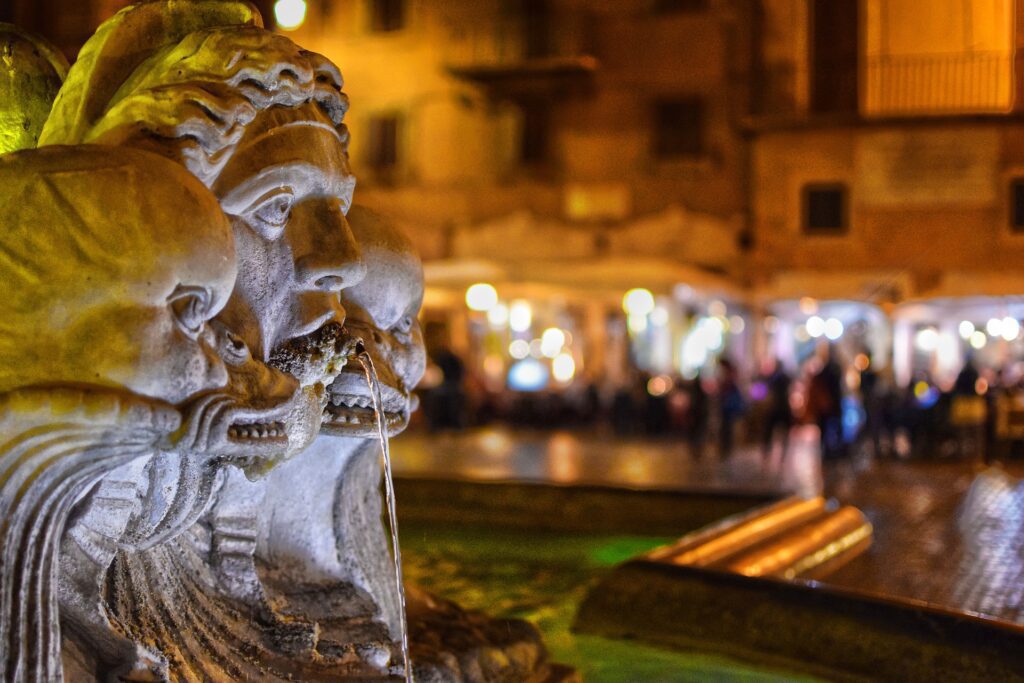
The Romans know how to party and have a good time – the rising number of nightclubs is a testament to that fact. If you’re not into clubbing, many of Rome’s trendy bars serve aperitivo, or the Italian version of Happy Hour, for you to relax and unwind. The rise in upscale restaurants that serve food from all around the world points to the changing tastes of the Romans and its rise as a global city. Speaking of food, Rome’s solid and distinctive style of cooking sets it apart from the rest of Italian cuisine. The Romans liked to push boundaries regarding their food, as shown in their bold use of ingredients. Rome’s pizza al taglio, pizza by the slice, their suppli (fried rice ball with mozzarella), and the spaghetti carbonara are some must-try delicacies. And if you’ve got a sweet tooth, Roman croissants and bread, especially the crostata ricotta and torta ricotta with cherries, are delicious.
With a rich history, cobble-stoned paths, stunning architecture, and centuries-old palaces – Rome has it all.
Colosseum
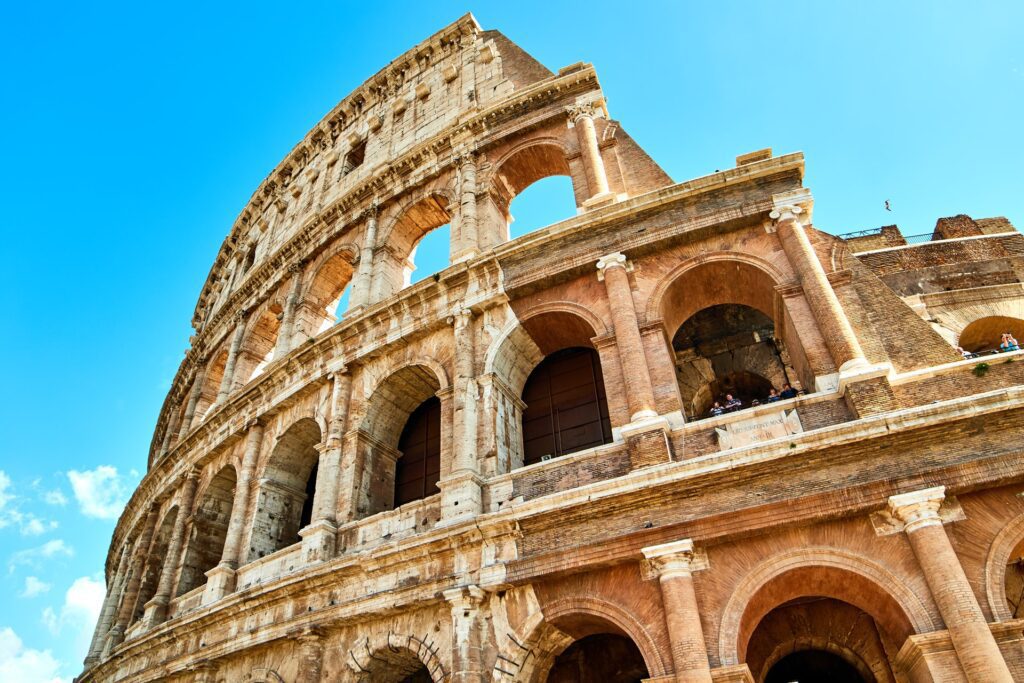
An enduring icon of the Roman World, the Colosseum is a 620 by 513 feet elliptical building, once the site of an artificial lake. The lake was drained to make way for the Colosseum, signifying the authoritarian rule’s end. Built to accommodate 60,000 seated people and another 10,000 standing guests, the theater was crowded with at least 70,000 spectators at any given time. The outer facade of the building, equivalent to a 12-story building, has columns and arches built using different styles: Tuscan at the bottom, Ionic in the middle, and Corinthian at the top. Instead of arches and columns on the fourth level of the Colosseum, the building features small windows. While the rest of the Colosseum was mainly white, the Arena was made using red and black stone blocks. The Romans covered the arena’s wooden floor with sand to prevent the combatants from slipping and make cleaning easy post-gladiator fights!
Borghese Gallery
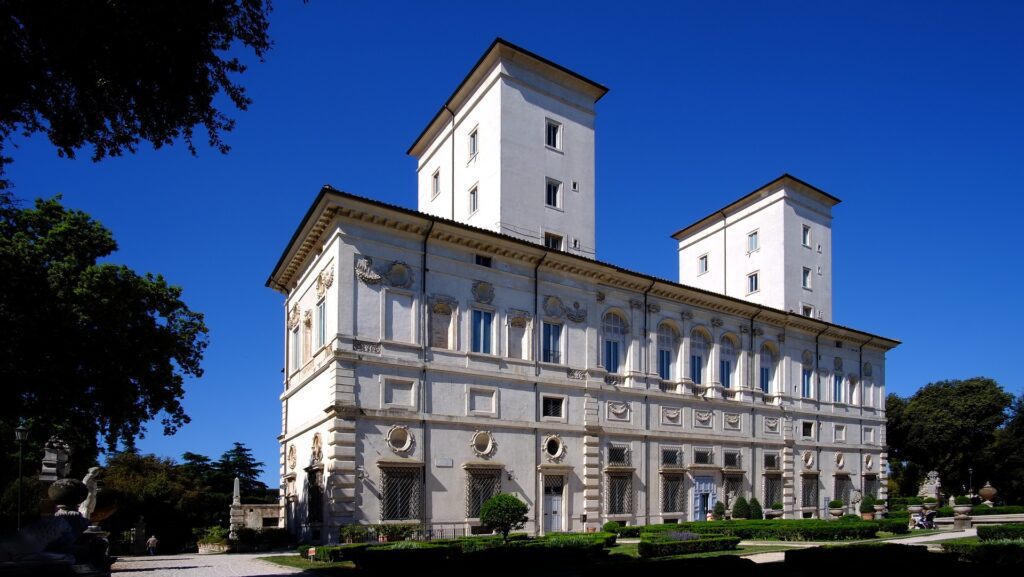
The Borghese Gallery is one of the most famous art galleries in the world. It is in Rome, Italy, and housed in the former Villa Borghese Pinciana. The gallery houses a considerable part of the Borghese collection of paintings, sculptures, and antiquities, begun by Cardinal Scipione Borghese, the nephew of Pope Paul V (reign 1605–1621). The gallery attracts thousands of visitors, and astonishing green gardens surround it in the third largest park in Rome, on the territory of which the Galleria Borghese is located.
Villa Borghese
Villa Borghese of Rome is one of the largest urban parks in Europe. The State acquired the gardens from the Borghese family in 1901 and opened them publicly on 12 July 1903. The perfect combination of nature and Roman art differentiates Villa Borghese from other large parks, such as Hyde Park or Central Park. Villa Borghese is home to interesting architectural elements, sculptures, monuments, and fountains created at different times by famous artists.
Roman Forum and Palatine Hill
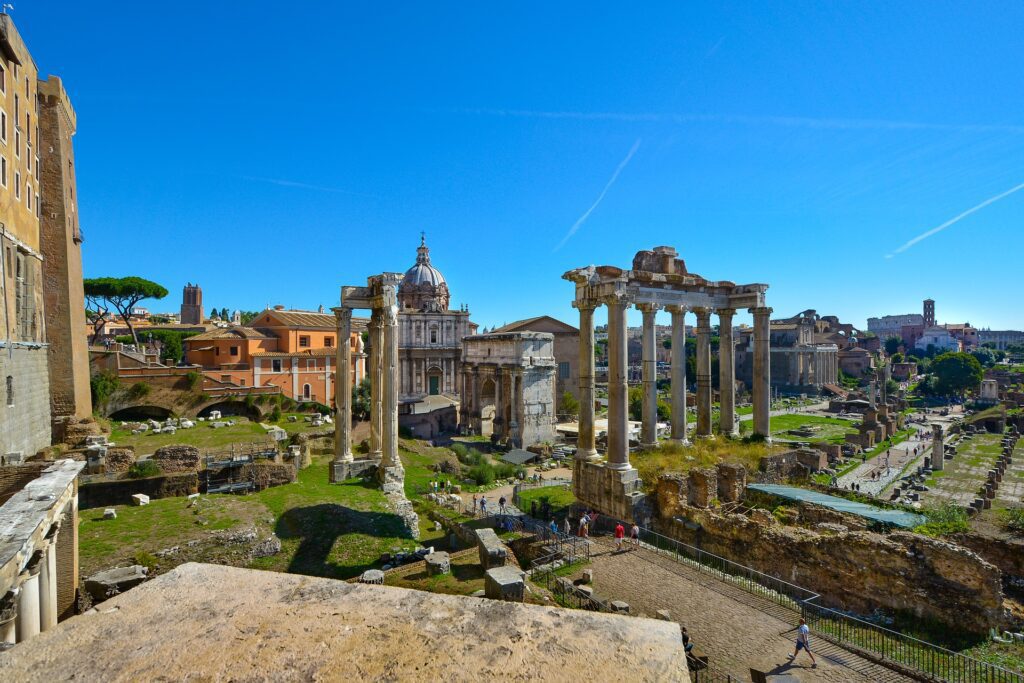
The Foro Romano (Roman Forum) is located just to the west of the Colosseum and is the truly ancient city of Rome. In this very place, history took place, with processions, criminal trials, elections, and intrigue all happening here. It was the site of the original Senate and where Caesar’s body was brought following his assassination. The ruins of some of Rome’s most important ancient structures can be found at or near the Forum. The flat-topped Palatine Hill that rises above the Forum is where the emperors built their palaces (and indeed “Palatine” is the source of the word “palace”. Contrary to the beliefs of some visitors to Rome, it is not the Palantine Hill, and nor is it the Palpatine Hill!) To visit this incredible place, there is a path from the eastern end of the Forum that leads up to the plateau on which Augustus Caesar built his first palace. Eventually, Emperor Domitian grew it into a genuinely vast building containing swimming pools, saunas and fountains, and even a sports stadium. He extended it to the other edge of the hill to overlook the Circus Maximus, where he could watch the chariot races now immortalized in the action sequences of Ben Hur without mingling with the hoi polloi.
Arch of Constantine
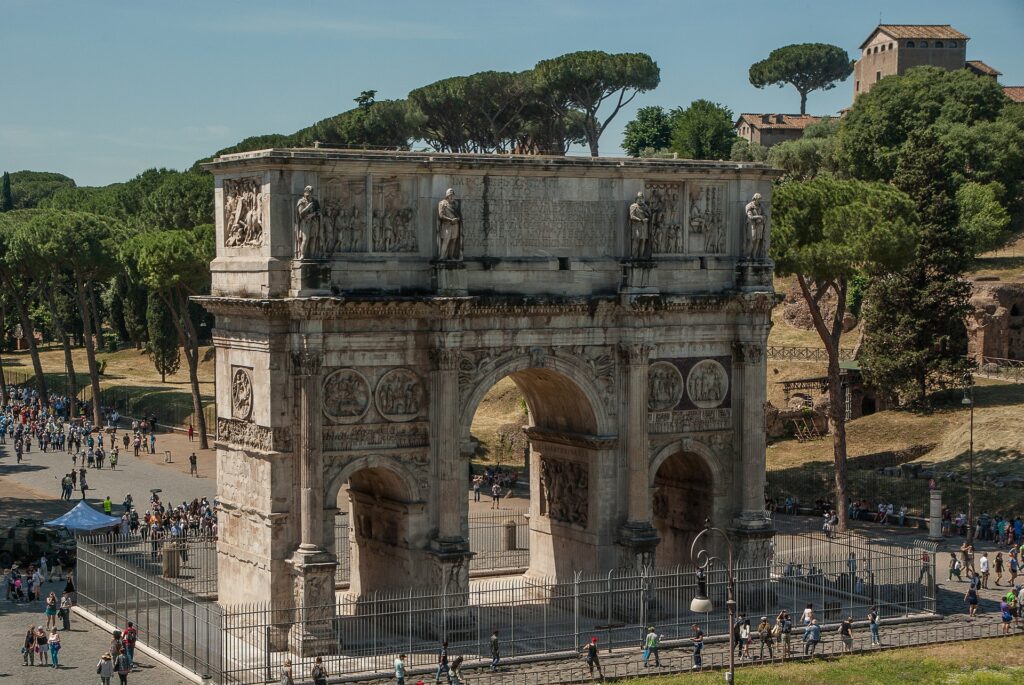
The Arch of Constantine was erected in the year 315 in commemoration of the victory of Constantine I the Great in the Battle of Milvian Bridge. It is located between the Colosseum and the Palatine Hill. Constructed from pieces of previous buildings, the Arch of Constantine is the most modern of the triumphal arches that were built in ancient Rome. It is 21 meters high, 25 meters wide, and comprises three arches. The reliefs on the monument, which were carved on blocks of marble, display statues taken from Trajan’s Forum and some reliefs showing Marcus Aurelius distributing bread among people experiencing poverty, as well as a representation of Trajan after his victory over the Dacians. The inscription on the upper part, initially cast in bronze letters, states the following: “To the Emperor Caesar Flavius Constantinus, the greatest, pius, and blessed Augustus: because he, inspired by the divine, and by the greatness of his mind, has delivered the state from the tyrant and all of his followers at the same time, with his army and only the force of arms, the Senate and People of Rome have dedicated this arch, decorated with triumphs.”
Vatican Museums
Considered one of the world’s most sacred locations for Christians worldwide, Vatican City is home to many iconic landmarks attracting millions of tourists annually. Visiting the Vatican is an experience you will never forget, and a plethora of museums await your arrival. Despite being the smallest country in the world with an area of 44 hectares, it’s home to various religious and cultural sites and treasures immense priceless collections of artistic and historical masterpieces by the world’s greatest artists across the famed Vatican Museums.
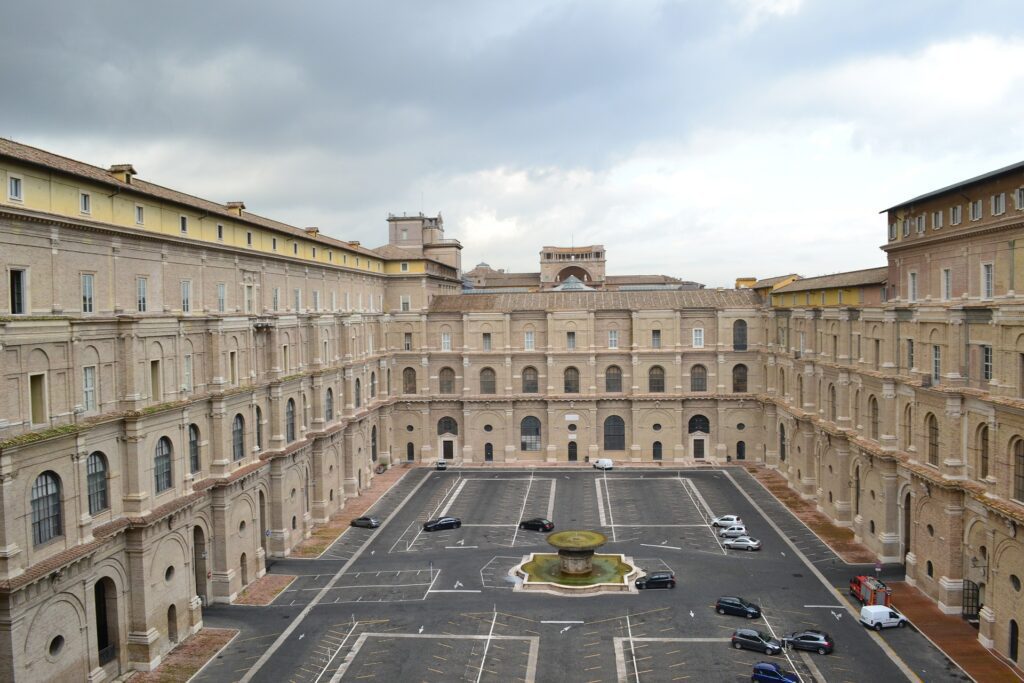
The Vatican Museum comprises 54 museums, and their collections are housed in the Vatican Palaces. The compilation in the museum is art produced over 800 years. Many famous artists of this time, including Giotto, Fra Angelico, Perugino, Melozzo da Forlì, Raphael, Leonardo da Vinci, Titian, and Caravaggio, have contributed to the museum’s collection. If you are interested in Classical Sculptures, you must visit the Museums of Classical Antiquities, the Pio-Clementine Museum, the Museo Chiaramonti, the Braccio Nuovo Gallery, and the Gregorian Profane Museum. Their gatherings include statues, sculptural groups, reliefs, friezes, urns, and mosaics. Here are some of the other prominent ones you cannot miss:
Gallery of Contemporary Art
The collection of contemporary art is a compilation of 800 works of art by over 250 international artists. This collection is dated from the late 19th century to the early 20th century. It took over ten years for Paul Ⅵ’s secretary, Msgr. Pasquale Macchi to compile them. It includes essential figures from artists such as Van Gogh Bacon and provides perspective on how religious art has evolved over the centuries.
Gallery of Maps
Located on the west side of the Belvedere Courtyard, the Gallery of Maps contains a series of painted topographical maps of Italy based on drawings by famous geographer Ignazio Danti. The 40 panels of the 120m long gallery map the Italian peninsula in large-scale frescoes with almost 80% accuracy.
The Spiral Staircase

Bramante designed this iconic staircase, which was later, in 1932, designed by architect Giuseppe Momo, whom the original one inspired. It is shaped like a double helix with two sets of staircases designed so that guests going up do not cross paths with those descending. This makes an excellent photo op. Make sure you visit before you exit the museum to the Sistine Chapel.
The Raphael Rooms
Marking the High Renaissance period in Rome, the four Raphael rooms, known as the Stanze of Raphael, give you the experience of a lifetime. Famed for their stunning pictorial decoration frescoes, painted by Raphael and his school, these rooms on the Pontifical Palace’s second floor are a must-see.
Sistine Chapel
One of the most revered tourist attractions in Vatican City and even the world, the Sistine Chapel is a chapel in the Apostolic Palace. The papal chapel has tremendous religious significance and is where popes are crowned. For tourists, the primary appeal of the Sistine Chapel is the collection of Renaissance frescoes by Michelangelo. The origins of the Sistine Chapel date back to the mandate of Pope Sixtus IV and construction work was carried out from 1473 to 1481.
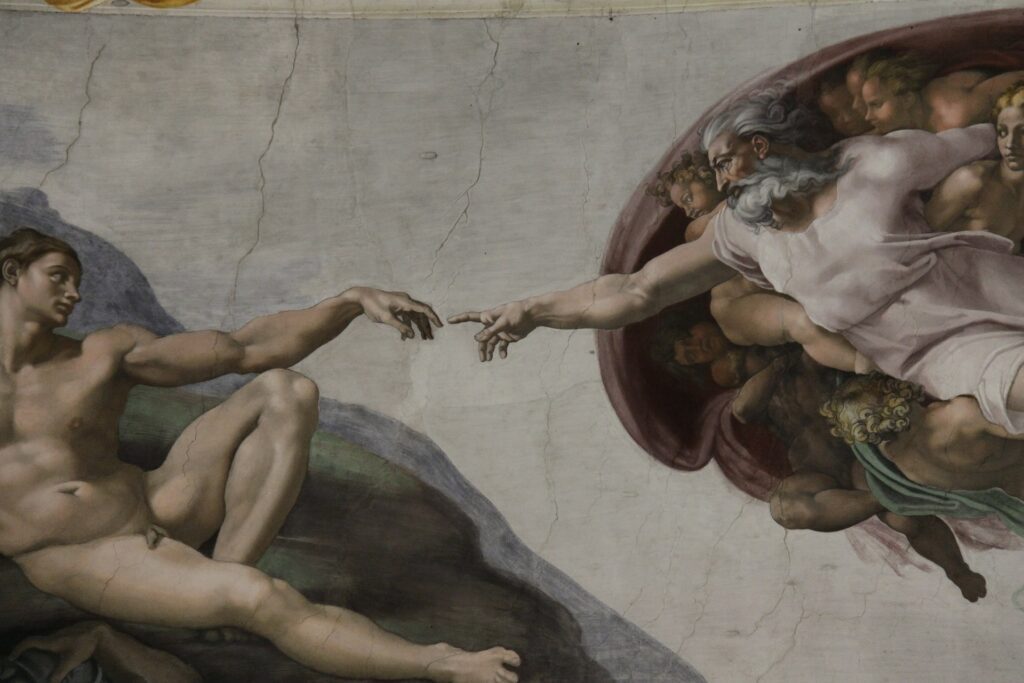
The beautiful papal chapel was designed by architect Giovanni of Dolce. Still, more than the actual building, what makes the Sistine Chapel a remarkable landmark are the frescoes that dot the walls and the ceiling. An enviable group of renowned artists, including Luca, Michelangelo, Perugino, and Botticelli, has created the frescoes. Your trip to the beautiful Sistine Chapel will be a part of a tour of the legendary Vatican Museum, amongst the world’s most loved landmarks.

The last stop in your Vatican Museum tour, the Sistine Chapel, is worth the wait. The glory and aura of the Sistine Chapel are hard to describe in words, but your experience here will be memorable. As you step into the revered halls of the chapel, you’ll be surrounded by breathtaking frescoes steeped in history and depict incidents and personages from the Old Testament. While the interiors feature masterful artwork by artists at the height of their power, the Sistine Chapel exteriors are entirely different. The building exteriors feature imposing and powerful walls and ramparts, similar to an old strongbox housing priceless treasures. Learn everything about the Sistine Chapel to make your visit to the acclaimed chapel even more enlightening and rewarding.
Gallery of Statues
This is one of 54 galleries in the Pio-Clementino Museums, filled with masterpieces of Greek and Roman sculpture. The walls were once covered with frescoes showing landscapes and cities. Small cupids painted by Pinturicchio and his assistants are still visible and worth a watch. The walls carry a series of niches displaying massive statues, interspersed with columns supporting outsize busts.
Gregorian & Egyptian Museum
The Gregorian Etruscan Museum is dedicated to Etruscan antiques and conserves the rare artifacts unearthed in the excavations carried out in the prominent cities of ancient Etruria, as well as other works collected over centuries and held in the Vatican. The Egyptian Museum, on the other hand, brings to light Egyptian-influenced Rome, the history of pharaonic culture, and the splendid setting of Hadrian’s Villa in Tivoli, amongst other things.
Vatican Gardens
More than two-thirds of Vatican City is covered with the Vatican Gardens behind the Leonine walls. The Vatican Gardens were groomed to provide the Vatican City with exorbitant beauty and to serve as a vital refuge for travelers since the Middle Ages. This is because Rome experiences sweltering summers. The landscape of these gardens is a combination of the characteristics of Italian, English, and French gardens. During the 1590s, the Gardens were adorned with many cascades and fountains. Out of these 100s of fountains, the Galea fountain (Fontana Della Galera) is an impressive one that is often overlooked. The massive water-filled basin carrying the modern warship is at the left of the Bramante Staircase.
Vatican Necropolis
Burial sites offer insight into the place’s cultural practices, society, and history. Little do people know that these sites also spill tea about their best-kept secrets. The Vatican Necropolis is one such site that tells a lot about the past of the Vatican, its various traditions, and mysteries. Located beneath the St. Peter’s Basilica, over 2,000 years of Roman history lies in the Vatican Necropolis. It is considered the final resting place of St Peter, the Apostle. Also, it is an ancient pagan and Christian cemetery from the 1st century. Due to its historical, religious, and cultural importance, extraordinary measures are taken to preserve this holy place and protect its integrity.
St. Peter’s Basilica

St. Peter’s Basilica dominates the skyline of Vatican City and is often used as the representative structure of this tiny nation. Every inch of St. Peter’s Basilica is heavily laden with architectural genius and historical significance. The cupola tour is one of the most exhilarating and awe-inspiring activities at St. Peter’s Basilica. Michelangelo’s stunning dome, which stands 452 feet tall, was built in 1546. You can take the elevator for 7 euros and skip some, though not all, of the stair climbing. If you want to get some cardio, take the stairs for 5 euros. Be warned, the stairs are much more difficult to ascend than the elevator, and there aren’t many views to enjoy. From the roof, you can take in the fantastic view of Piazza San Pietro and the unique view of the nave and altar. The basilica’s interior consists of numerous works of art you witness during your visit. Significant discoveries and excavations have also been made beneath the basilica’s surface. Some of the original 4th-century church pillars have been discovered beneath the surface of St. Peter’s Basilica. Recently, it has been unofficially said that the Tomb of St. Peter has been found to contain the skeleton of St. Peter. In addition to all these, you can also visit St. Peter’s Basilica to receive a Papal Blessing every Wednesday.
Castel Sant’Angelo
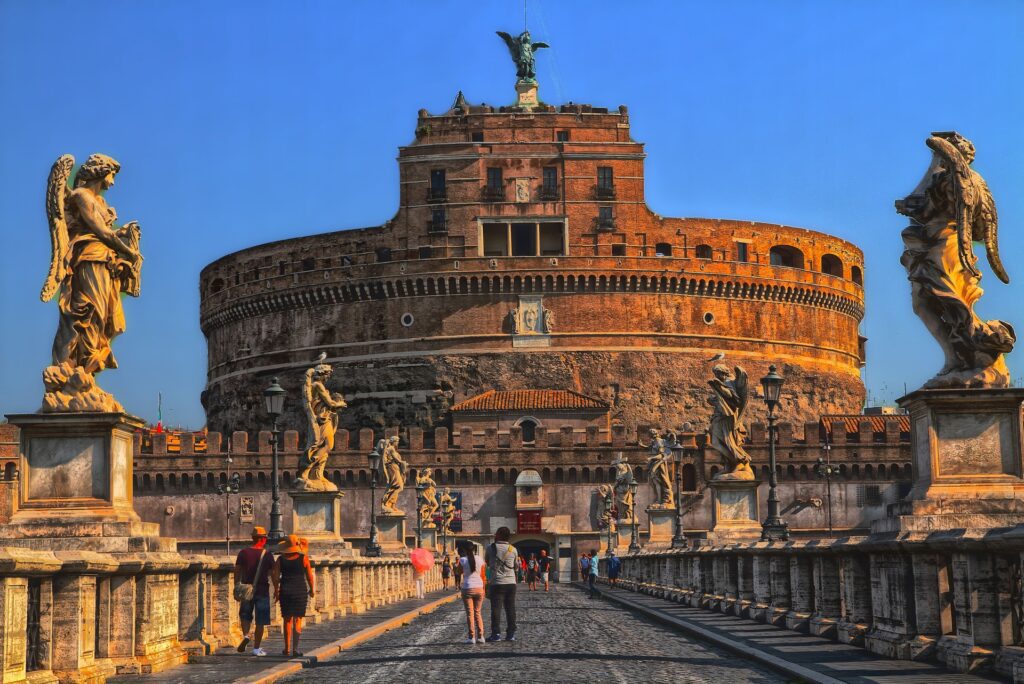
The Castel Sant’Angelo is split into five floors, which can be reached by a spiral ramp that first reaches the chamber of ashes and, subsequently, the cells in which several historical figures were incarcerated. Advancing toward the upper part of the castle, you will find different rooms that functioned as a Papal residence, decorated with perfectly preserved frescoes from the Renaissance period, besides the extensive collection of weapons. On the upper floor, there is a large terrace where you can take amazing photographs of the city from above.
Trastevere and Jewish Ghetto

This must-see sightseeing tour of Rome guides you through the charming, historic neighborhoods of Trastevere and the Jewish Ghetto – two of Rome’s best places to visit. Crossing over Tiber Island, we enter the pretty quarter of Trastevere, a sleepy village in the city’s heart, on a midweek morning, where we will visit the medieval churches of Santa Cecilia and Santa Maria in Trastevere and their gleaming mosaics. The Jewish area is known in Rome as the Ghetto. Both the Jewish Ghetto and Trastevere have histories that tell another side of life in Rome over the past 2,000 years. In this small group tour, you will learn about the gripping history of the Jewish population in Rome and their impact on the city’s ancient and contemporary life.
Trajan’s Market
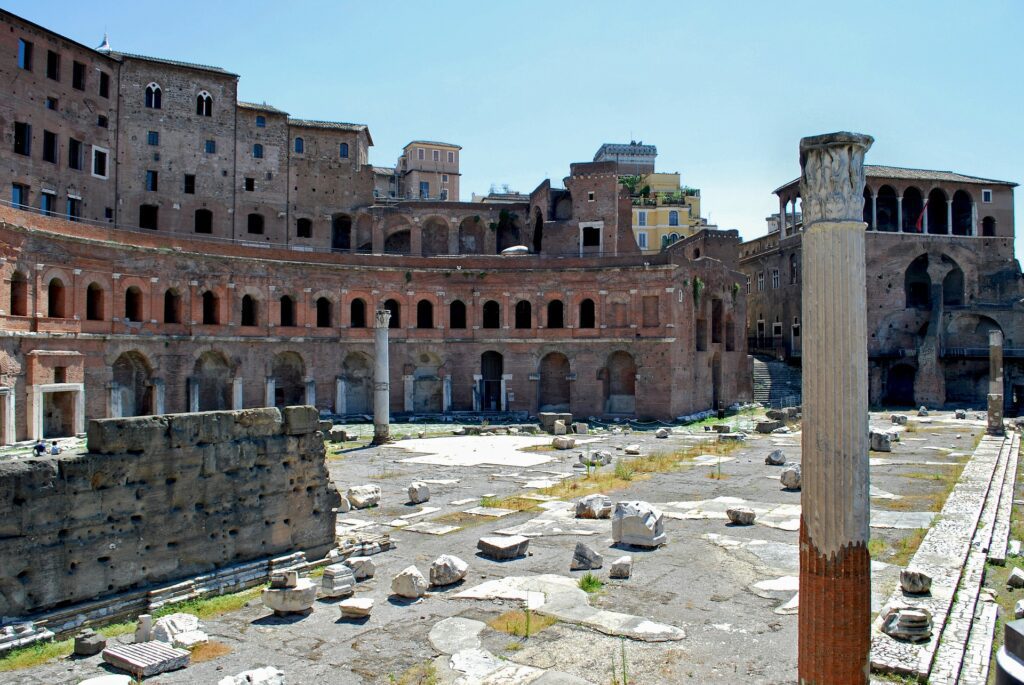
Situated on Via dei Fori Imperiali, Trajan’s Market is an archaeological complex that currently houses the Museum of Imperial Forums (Museo dei Fori Imperiali). It is considered to be Rome’s first “shopping center.” The complex, made of red brick and concrete, had six levels in which up to 150 different shops and apartments were once located. Although it does not enjoy as much fame as the Colosseum, Trajan’s Market maintains an important part of its original appearance and offers an exciting visit.
Roman Catacombs
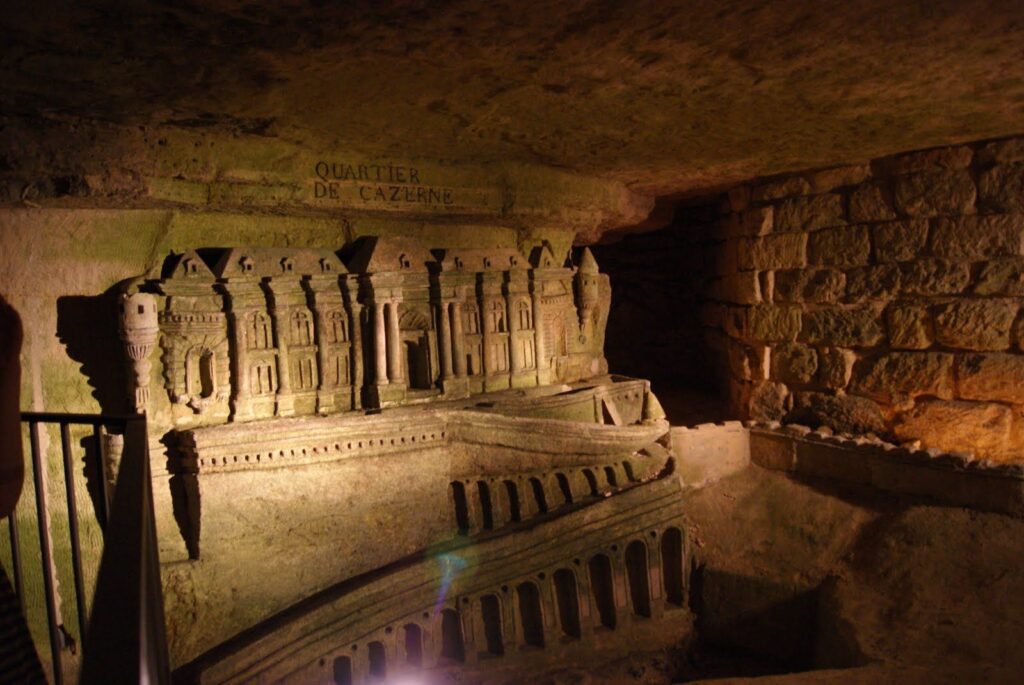
The burials of Jewish, pagan, and early Christian Roman citizens in the catacombs began in the second century and ended in the fifth century. The word catacomb, which means “next to the quarry,” comes from the fact that the first excavations used as a burial place were carried out on the outskirts of Rome, next to the quarry site. The Christians disagreed with the pagan custom of burning the bodies of their dead, for which reason, to solve problems created by a lack of space and the high price of land, they decided to make these vast underground cemeteries. The catacombs possess many subterranean passageways that form natural labyrinths several kilometers long, along which rows of rectangular niches were dug out. The corpses were wrapped in a sheet and placed in the niches, which were then covered with gravestones made of marble or, more commonly, baked clay. Subsequently, the deceased’s name was carved on the cover, and a Christian symbol was accompanied. Roman law at the time prohibited the burial of the deceased in the city’s interior, for which reason all of the catacombs were located outside the walls. These separated and hidden places below ground constituted the perfect refuge in which the Christians could bury their own freely using Christian symbols.
Pantheon

The Pantheon of Agrippa, also known as the Roman Pantheon, is one of the architectural masterpieces of the Italian capital. It is the best-preserved building from ancient Rome. The construction of the current Pantheon was carried out during the reign of Hadrian in the year 126 A.D. The name of Agrippa comes from where the current building was built, which was previously occupied by the Pantheon of Agrippa, built in the year 27 B.C and destroyed in a fire in the year 80 A.D. At the beginning of the 7th century, the building was donated to Pope Boniface IV, who transformed it into a church, where it currently finds itself in a perfect state of preservation.
Trevi Fountain

Trevi Fountain is the most beautiful fountain in Rome. Measuring some 20 meters in width by 26 meters in height, Trevi Fountain is also the largest fountain in the city. The origins of the fountain go back to the year 19 B.C. when the fountain formed at the end of the Aqua Virgo aqueduct. The first fountain was built during the Renaissance, under the direction of Pope Nicholas V. The final appearance of the Trevi Fountain dates from 1762 when after many years of works at the hand of Nicola Salvi, it was finalized by Giuseppe Pannini. Interestingly enough, the name of Trevi derives from Tre Vie (three ways), since the fountain was the meeting point of three streets. Why are there always people in the fountain throwing coins into the water and taking photos of themselves? The myth, originating in 1954 with the movie “Three Coins in the Fountain,” goes like this:
- If you throw one coin, you will return to Rome.
- If you throw two coins, you will fall in love with an attractive Italian.
- If you throw three coins, you will marry the person you met.
Throw the coin with your right hand over your left shoulder to achieve the desired effect. An interesting statistic is that approximately a million euros of coins are taken from the fountain yearly. Since 2007, this money has been used to support good causes.
Spanish Steps

The Spanish Steps are steps dating from 1723, climbing a steep slope between the Piazza di Spagna at the base and Piazza Trinita dei Monti at the top, dominated by Trinita dei Monti Church. The steps are at the eastern end of the old city center. From the base, a maze of very narrow lanes crammed full of designer shops is waiting to be explored. The Spanish Steps is still a place for artists, painters, and poets to visit. Today, at the top of the Spanish Steps, you will find a cluster of artists painting visitor’s portraits.
Mouth of Truth
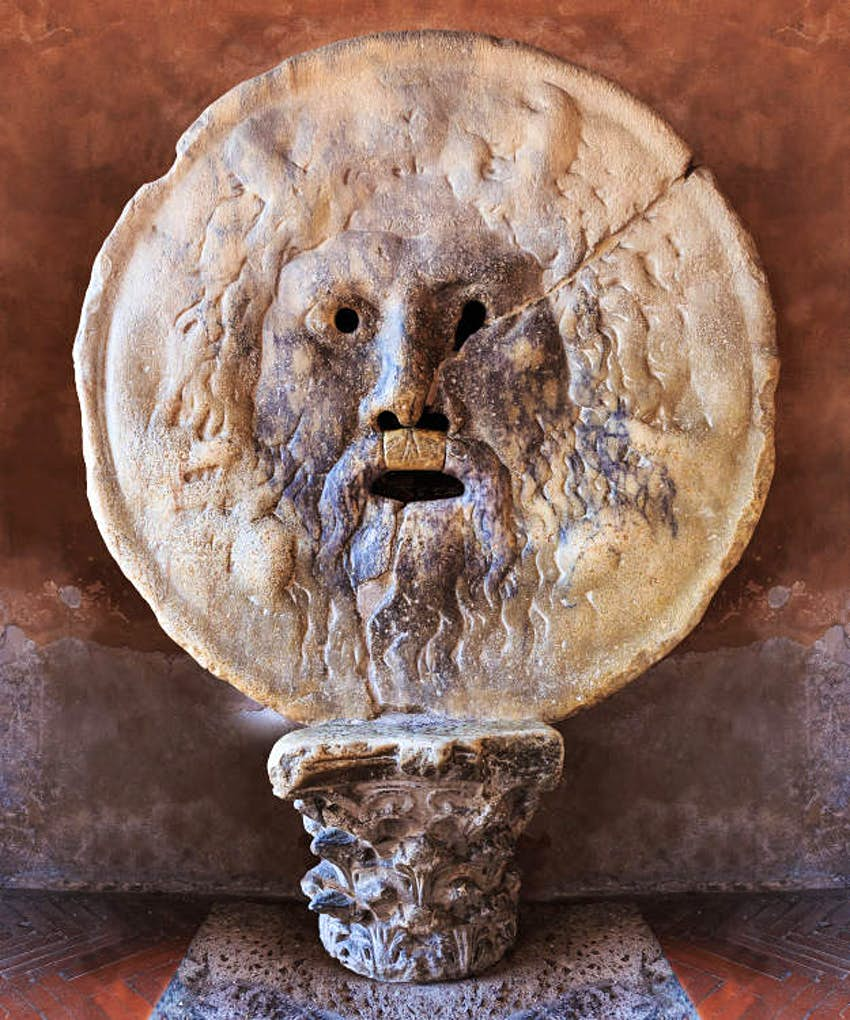
According to the legend, a husband who mistrusted his wife took her to the Mouth of Truth to test her faithfulness. The woman reacted by pretending to swoon, and her lover caught her in his arms. After this, the woman swore before the Mouth of Truth that she had only been in the arms of her husband and of the man who had just caught her. This is just one of the many legends regarding the famous sculpture that continues to generate enormous anticipation with the passing of time. The sculpture was once in the Piazza della Bocca della Veritá until 1632. It was then transferred to the outside of one of the walls of the nearby Santa María in Cosmedin, where it remains today. It is widespread to see many people lining up to be photographed with their hands inside the Mouth of Truth.
Baths of Caracalla
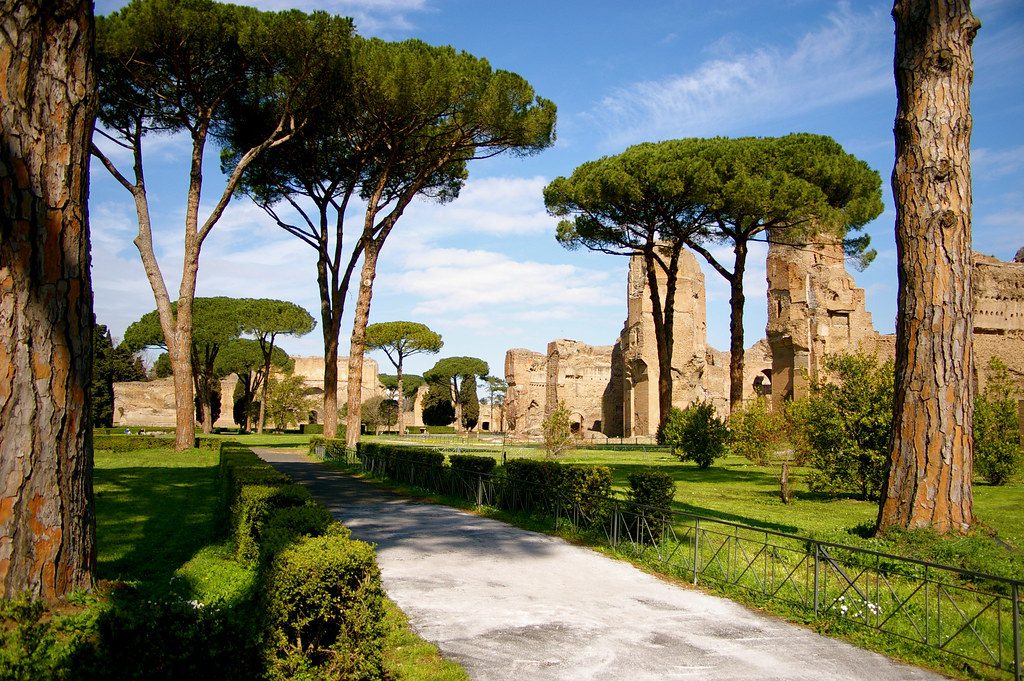
Built between 212 and 216 under the direction of Marcus Aurelius Antoninus Augustus, more commonly known as Emperor Caracalla, the Baths of Caracalla were among the most incredible and spectacular thermal complexes in ancient times. Even though today, only the brick walls and largely collapsed vaults remain, the remnant of the splendor of the Baths of Caracalla is still preserved.
Ara Pacis
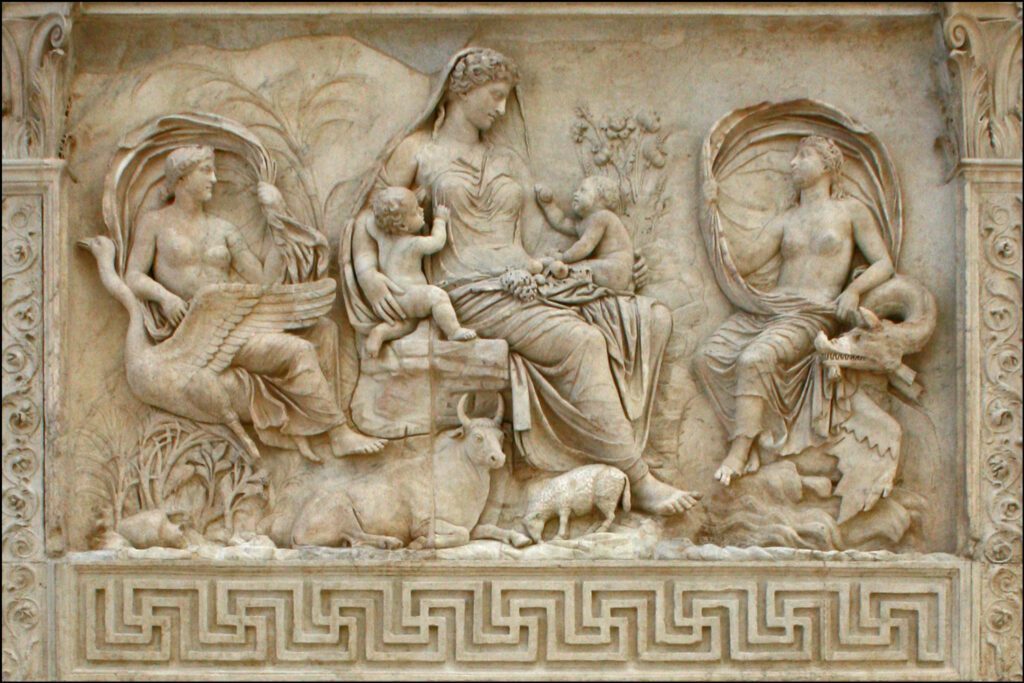
The Ara Pacis is an altar in the interior of a closed structure carved in Carrara marble. It stands out because of its impressive decoration of various reliefs showing the family of Augustus in procession, in addition to different allegories related to the mythical foundation of Rome.
Circus Maximus
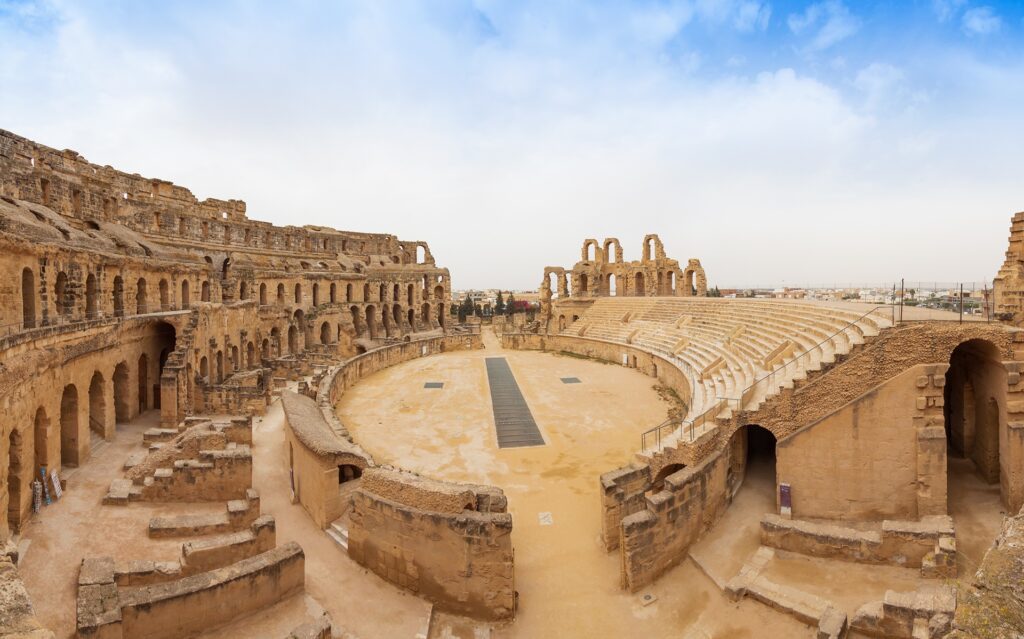
Roman circuses, apart from the theatres and arenas, were the most important entertainment centers in the Roman cities. They were extended precincts where the public games were held, consisting of chariot races and different spectacles. The Circus Maximus in Rome (Circo Massimo), located between the Aventino and Palatine Hills, was an extended precinct with space for 300,000 spectators. The arena, which measured 600 meters in length and 225 meters in width, made the Circus Maximus the largest in Rome, ahead of the Circus of Flaminius and the Circus of Maxentius.
Altare della Patria
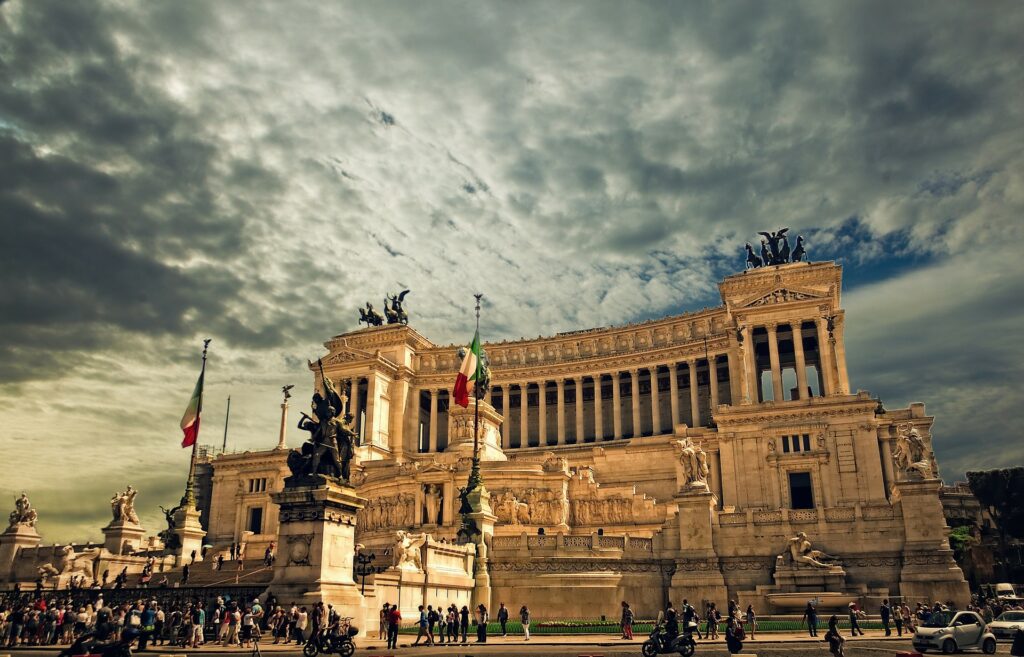
The colossal monument, which is 135 meters wide and 70 meters high, comprises scores of majestic Corinthian columns and endless stairs, all carved in white marble. The top is crowned with an equestrian sculpture of Victor Emmanuel cast in bronze and two chariots driven by the goddess Victoria. The monument was strongly criticized at its construction since it was necessary to knock down numerous valuable buildings for sufficient space. Italian citizens disagreed with the idea of having such an eye-catching and elaborate building next to the other classical buildings surrounding it.

The public square is built where the Stadium of Domitian (Circus Agonalis), founded in 86 AD, once stood. It could hold approximately 20,000 spectators who came here to watch different athletic competitions. The most beautiful parts of Piazza Navona are its three fountains, designed during the papacy of Gregory XIII: Fontana dei Quattro Fiumi, Fontana del Moro, and Fontana del Nettuno.
Piazza della Repubblica
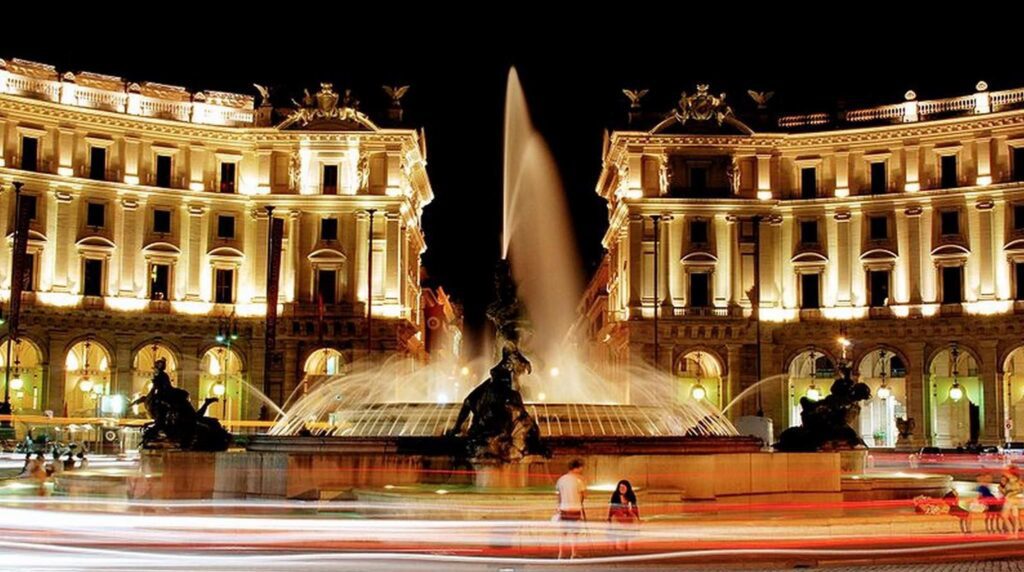
The Piazza della Repubblica has a large roundabout with an exquisite fountain, surrounded by imposing buildings on one side and a seemingly demolished temple on the other. It was formerly known as the Piazza dell’Esedra because it was laid down on the remains of an exedra (a semi-circular open room with seating) from the Diocletian era.








